Understanding the Employment Landscape for Autistic Adults
Adults with autism spectrum disorders (ASD) face a persistent and significant challenge in securing and maintaining employment, with rates markedly lower than those in the general population. Despite often having high educational qualifications and diverse professional skills, many autistic adults grapple with workplace environments and recruitment processes that do not accommodate their unique needs. This article explores the factors contributing to the autism unemployment rate and examines strategies, including therapeutic interventions like Applied Behavior Analysis (ABA), that aim to improve employment outcomes for this community.
Current Employment Rates Among Autistic Adults
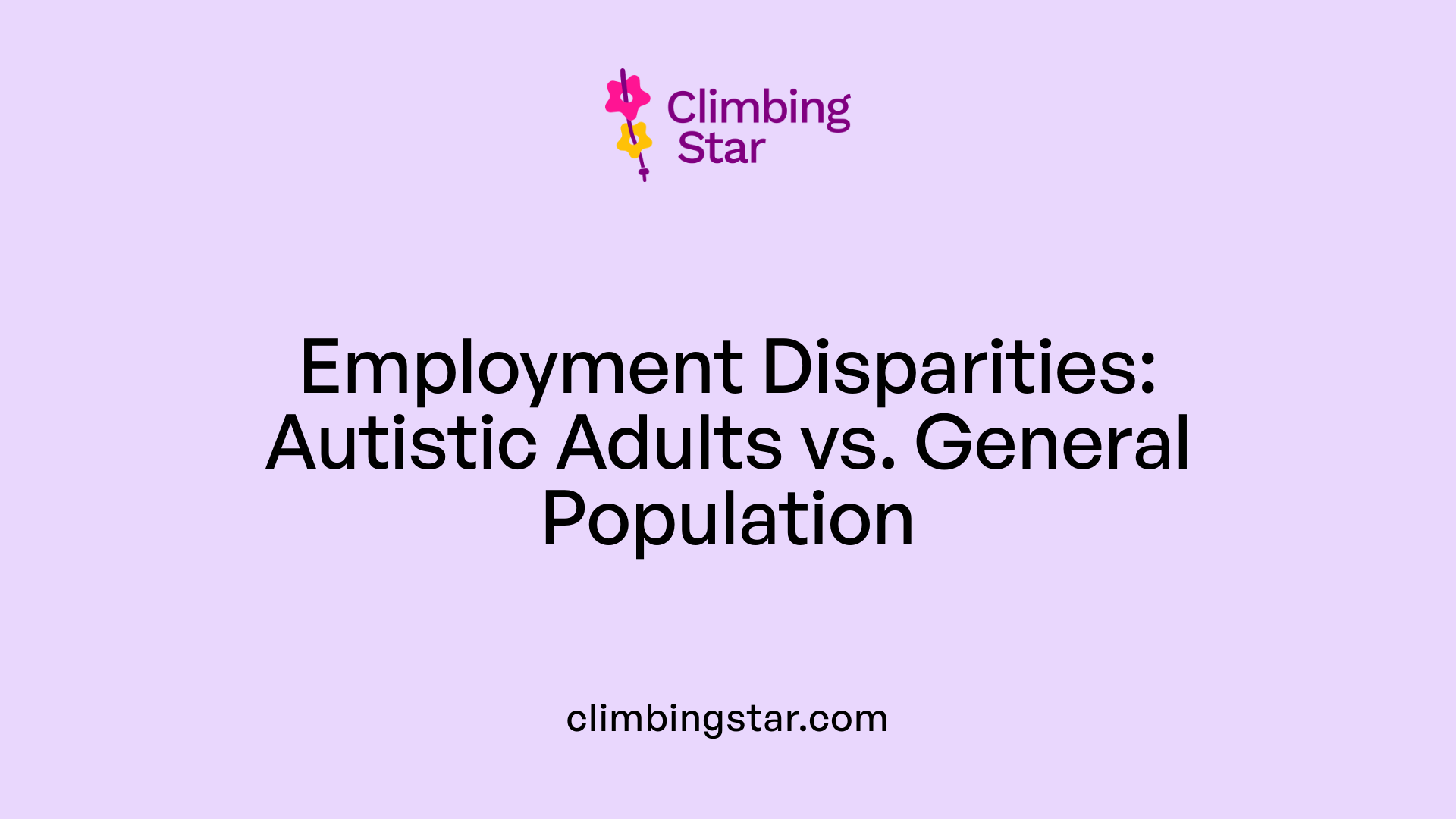
What is the autism unemployment rate compared to the general population?
Employment rates for autistic adults are notably low, with estimates ranging from approximately 21% to 27%. This figure is significantly below employment rates observed in the general population, highlighting a marked disparity in workforce participation.
This lower employment rate underscores the challenges autistic individuals face in securing and maintaining jobs despite many having high formal qualifications. Many adults with autism experience difficulties in various stages of the employment process, including recruitment, interviews, and workplace retention, which contribute to higher unemployment compared to the broader population.
The contrast between autistic adults and the general workforce emphasizes the need for tailored support strategies to bridge this employment gap. Addressing these disparities is crucial for fostering inclusive employment opportunities and enhancing economic participation for autistic individuals.
Common Workplace Challenges Faced by Autistic Employees
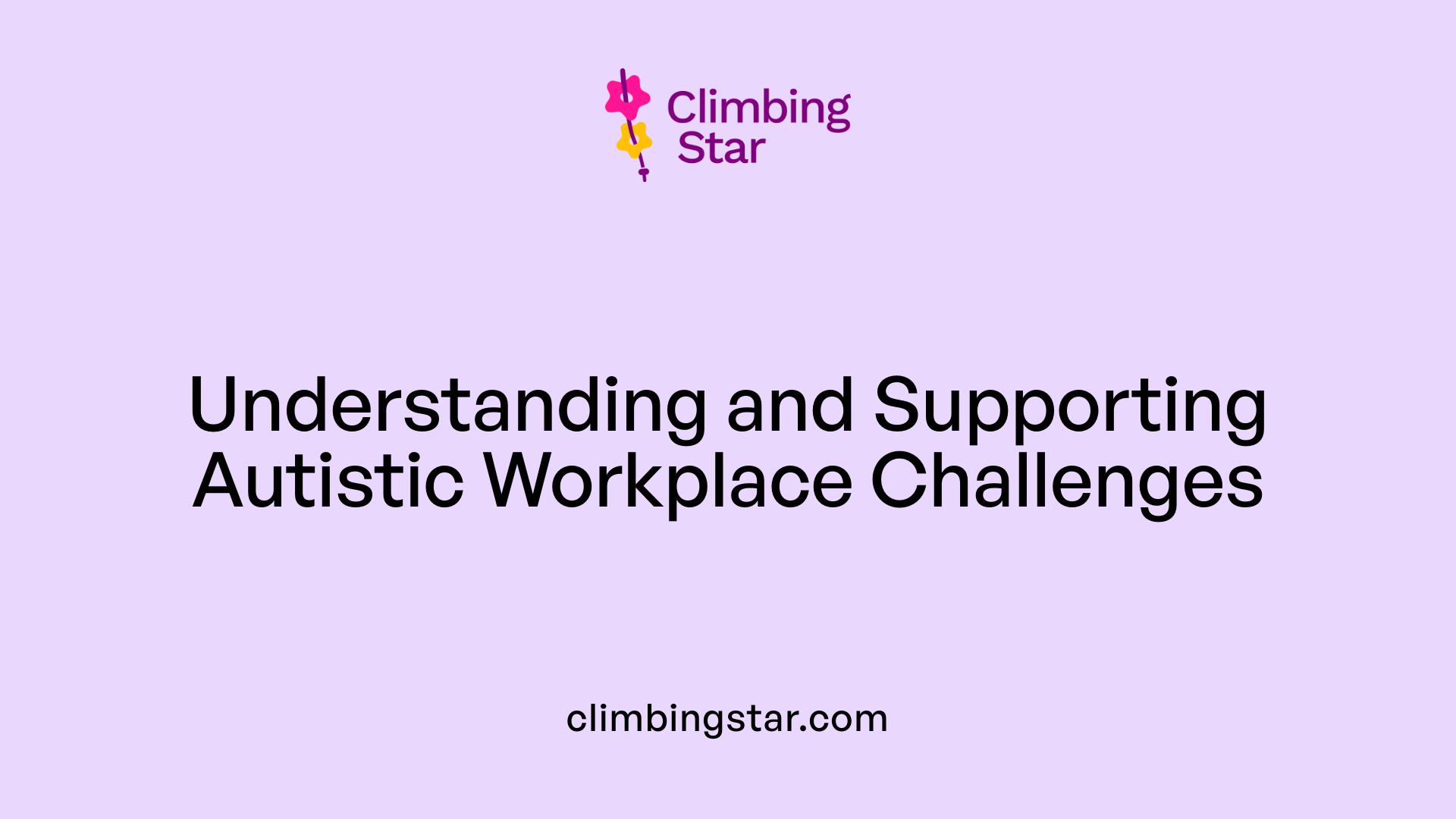
What are the workplace challenges faced by autistic individuals?
Autistic employees often experience several challenges in work environments that can impact their productivity and job retention. One major issue is communication differences. Autistic individuals might have unique ways of expressing themselves or interpreting information, which can lead to misunderstandings with colleagues and supervisors.
Sensory sensitivities also play a significant role. Many autistic workers are sensitive to stimuli such as bright lights, loud noises, or busy, fast-paced settings. When the workplace is noisy or unpredictable, it can become overwhelming, reducing their comfort and focus at work.
Social misunderstandings may occur because autistic individuals can interpret social cues differently. This can create challenges in team interactions or informal workplace communications, sometimes leading to feelings of isolation or difficulty fitting in.
Finally, adapting to routine changes at work may be difficult. Many autistic employees thrive on predictable schedules and clear expectations. Sudden shifts or disruptions in routine can cause stress and reduce performance.
Addressing these challenges with understanding and accommodations is essential for supporting autistic employees and improving their workplace experiences.
The Role of Applied Behavior Analysis (ABA) Therapy in Employment Preparation
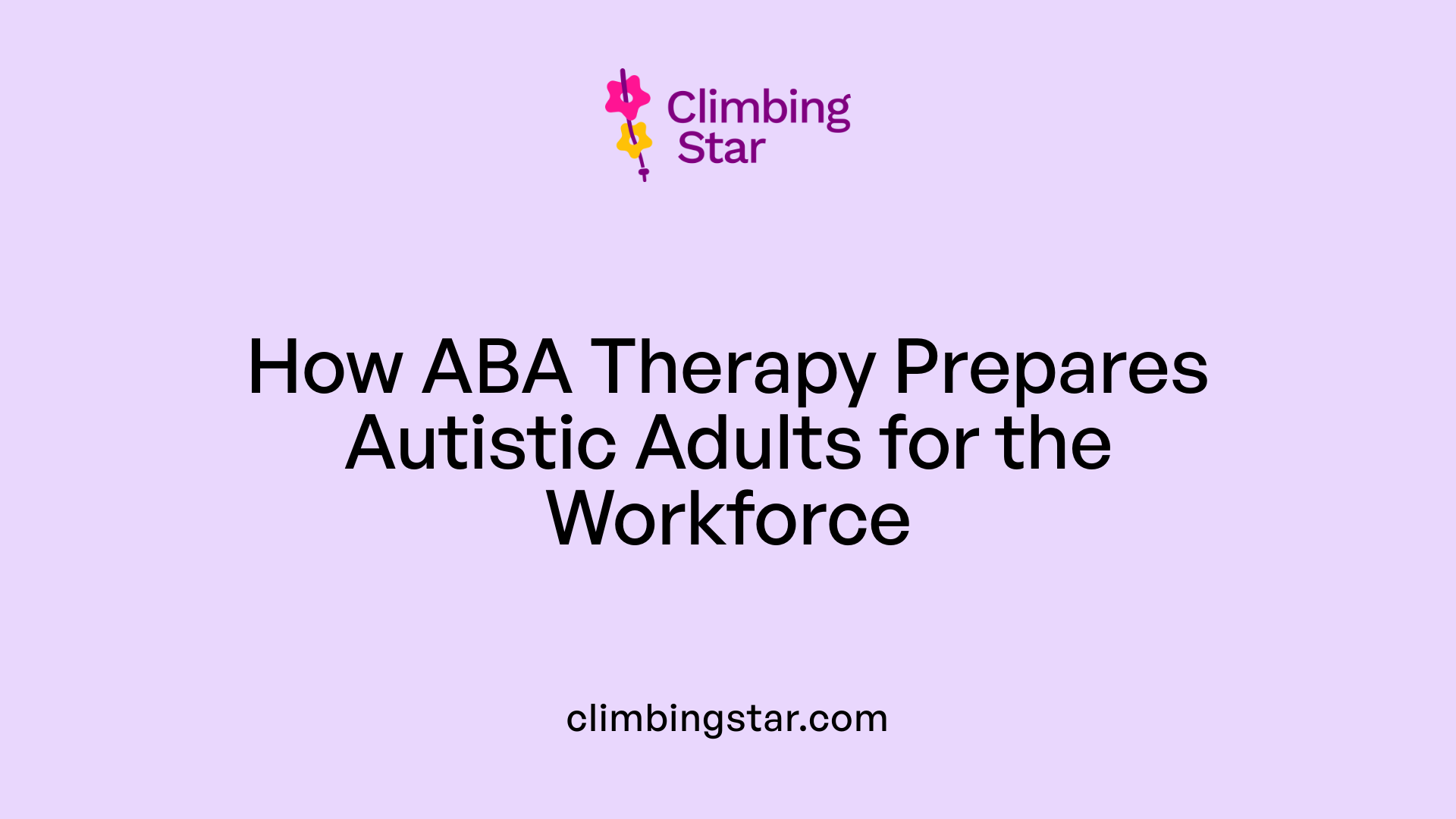
What is Applied Behavior Analysis (ABA) therapy?
Applied Behavior Analysis (ABA) therapy is a scientifically grounded approach that studies how the environment influences behavior with the aim of increasing helpful behaviors and decreasing harmful ones. It uses positive reinforcement techniques and detailed behavior assessments to develop tailored treatment plans.
Goal of ABA Therapy
The primary goal of ABA therapy is to support individuals in acquiring new skills and improving existing ones. It targets important areas such as communication, social interaction, self-care, and task completion. By focusing on measurable behavior changes, ABA creates structured interventions that suit individual needs.
Use of ABA Therapy in Autism Employment
Since the 1960s, ABA has been widely recognized as an effective evidence-based intervention for people with autism. In employment preparation, ABA helps teach job-related skills including following instructions, managing time, and completing tasks efficiently. It also strengthens social and communication abilities essential for workplace success.
Furthermore, ABA assists with self-regulation, helping autistic individuals manage sensory sensitivities and adapt to workplace routines. This comprehensive approach makes ABA therapy an important tool in preparing autistic adults for meaningful and sustained participation in the workforce.
How ABA Therapy Benefits Autistic Individuals in the Workplace

How does ABA therapy benefit individuals with autism?
Applied Behavior Analysis (ABA) therapy is a valuable tool for helping autistic individuals acquire essential skills that enhance their ability to succeed in the workplace. ABA focuses on developing practical abilities such as following instructions, managing time effectively, and completing tasks efficiently, which are crucial for job performance.
Additionally, ABA therapy supports social interaction skills by teaching communication techniques and fostering better understanding in workplace settings. This can reduce misunderstandings and help autistic employees build positive relationships with coworkers and supervisors.
Self-regulation is another important focus of ABA; it equips individuals to manage sensory sensitivities and anxiety that may arise in busy or noisy work environments. This ability to regulate emotions and responses supports greater job retention and satisfaction.
ABA strategies also contribute to broader skill development, building independence through daily living and self-care practices that complement workplace requirements. By preparing autistic adults with these competencies, ABA therapy increases the likelihood of stable employment and a smoother transition into various professional fields.
Overall, ABA therapy acts as a strong foundation that empowers autistic employees to navigate common workplace challenges and thrive in their careers.
Qualifications and Providers of ABA Therapy

Who provides ABA therapy and what qualifications do they have?
Applied Behavior Analysis (ABA) therapy is primarily provided by professionals trained and certified through the Behavior Analyst Certification Board (BACB). Two main types of providers include Board Certified Behavior Analysts (BCBAs) and Registered Behavior Technicians (RBTs).
BCBAs are highly trained practitioners who hold a master's degree or higher in behavior analysis or a related field. They design, oversee, and manage individualized treatment plans for clients with autism spectrum disorder (ASD). Their role involves assessing the client's needs, creating tailored interventions, training other staff, and monitoring progress to ensure effective outcomes.
RBTs work under the supervision of BCBAs and are responsible for the day-to-day implementation of ABA programs. They hold a high school diploma or equivalent and complete specialized training and competency verification to become certified. Their duties include delivering therapy sessions, collecting data on client progress, and applying specific behavioral techniques as outlined by the BCBA.
Both certifications emphasize evidence-based approaches and ethical treatment. The rigorous standards of training, ongoing education, and supervision guarantee that clients receive quality assistance tailored to their unique challenges and strengths. Through this structured teamwork, ABA therapy effectively supports skill development in job readiness, social communication, and self-regulation for individuals with ASD.
Variations within ABA Therapy Approaches

Are there different types or approaches within ABA therapy?
Yes, ABA therapy includes several distinct approaches designed to meet various learning needs and environments. One common method is Discrete Trial Training (DTT), which uses structured, repetitive learning trials to teach specific skills. This approach helps break down complex tasks into smaller, manageable steps, making learning clear and sequential.
Another approach is Natural Environment Teaching (NET), which encourages learning through everyday activities in real-life settings. NET is more flexible than DTT and helps individuals generalize skills by practicing them naturally as part of their daily routines.
Verbal Behavior (VB) therapy is specifically targeted at improving language and communication skills. It focuses on teaching the functional use of language, such as requesting, labeling, and conversing, to enhance social interactions.
ABA also employs various behavior change techniques like reinforcement, prompting, chaining, and modeling. These strategies are tailored to individual needs, helping to effectively teach job-related skills such as following instructions, managing time, completing tasks, and developing social and communication abilities.
By combining these approaches, ABA therapy creates a comprehensive system that supports learning and skill development in autistic individuals, improving their readiness and success in employment and everyday life.
Initiating ABA Therapy: Assessment to Implementation
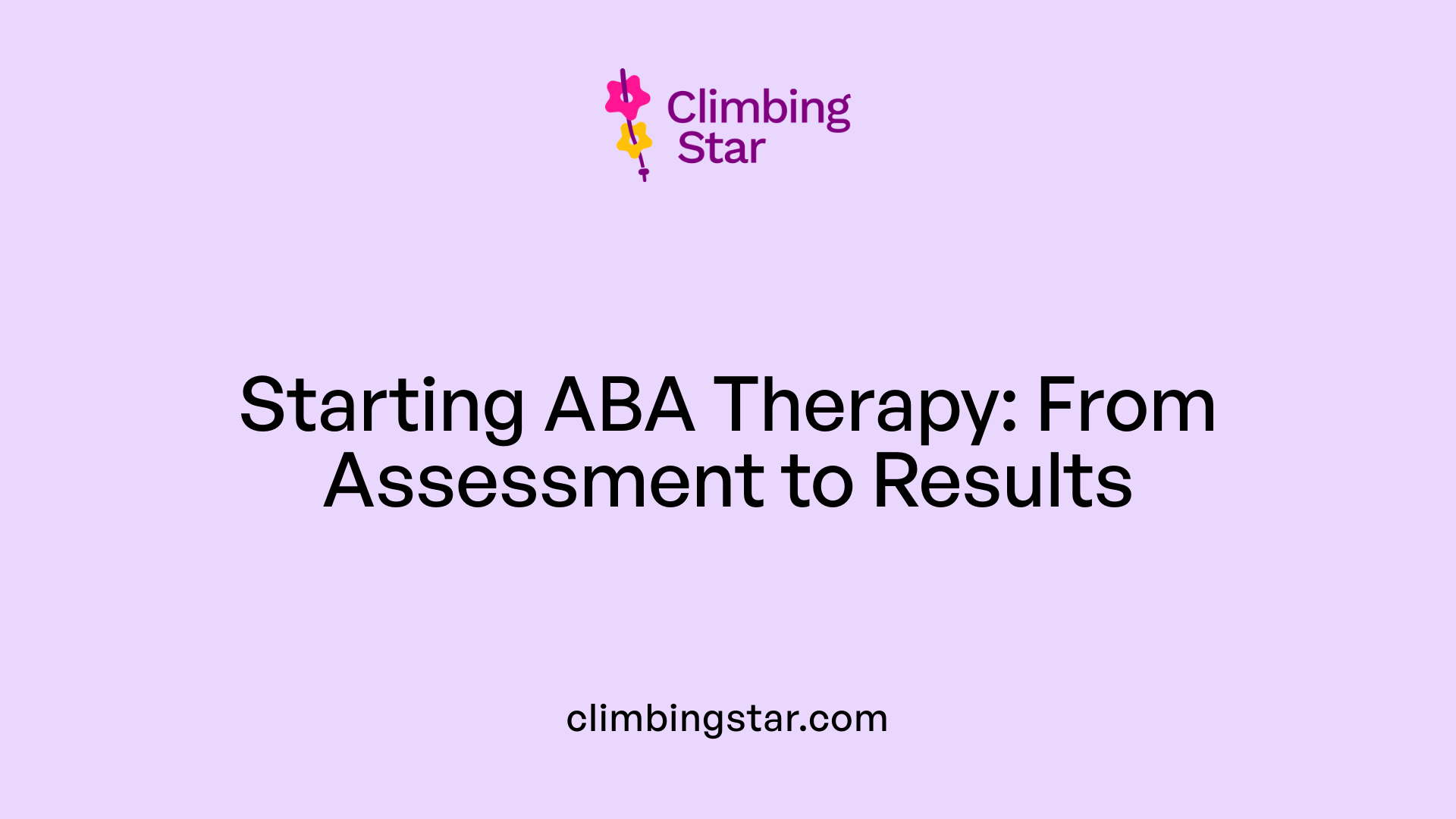
What is the typical process of starting ABA therapy for someone with autism?
Beginning ABA therapy typically starts with a detailed assessment conducted by a Board Certified Behavior Analyst (BCBA). This comprehensive evaluation focuses on key areas such as communication abilities, social skills, and specific behavioral patterns. The findings enable the BCBA to create a personalized treatment plan tailored to the individual's strengths and areas needing support.
Assessment Process
Initial assessment sessions involve observing the individual in different environments, interviewing caregivers, and using standardized tools. This helps identify skill deficits and behaviors that may impact daily functioning and learning.
Treatment Planning
Based on assessment outcomes, the BCBA designs a structured and individualized therapy program. Goals might include teaching job-related skills like following instructions and time management, as well as addressing social communication and self-regulation needs.
Therapy Settings
ABA therapy sessions are typically delivered by Registered Behavior Technicians (RBTs) under BCBA supervision. These sessions can take place in varied environments such as the individual's home, clinics, schools, or workplaces, depending on what best suits their needs.
Ongoing Evaluation
A fundamental component of ABA therapy is continual progress monitoring. Regular reviews allow the BCBA to adapt the treatment plan as the individual grows and their skills evolve. Parent and caregiver training is also integral, ensuring support and skill generalization beyond therapy sessions.
This structured approach ensures that ABA therapy effectively supports the development of functional skills crucial for enhancing employment opportunities and workplace success for autistic individuals.
Influence of Workplace Environment on Employment Stability

How do sensory sensitivities affect autistic employees at work?
Many autistic individuals experience heightened sensory sensitivities that make standard workplace environments challenging. Noisy, fast-paced, or unpredictable settings can cause sensory overload, leading to increased anxiety and difficulty concentrating. This sensory discomfort often results in decreased job satisfaction and can threaten stable employment for autistic workers.
Impact of noise and unpredictability
Workplaces with constant background noise, sudden changes, or hectic schedules tend to overwhelm those with sensory sensitivities. Such environments disrupt routines and can trigger stress or shutdowns, making it harder for autistic employees to meet job expectations consistently.
Effective employer accommodations
Employers can play a crucial role in creating stable work experiences by adapting environments to suit autistic employees’ sensory needs. Successful accommodations include:
- Providing quiet, low-stimulation workspaces
- Using visual aids to support communication
- Allowing the use of noise-cancelling headphones
- Offering flexible work arrangements such as remote work or adjusted schedules
Implementing these accommodations helps reduce sensory overload and fosters a more inclusive workplace. When autistic employees feel supported, their performance improves, and they are more likely to maintain long-term employment.
Recognizing and addressing sensory challenges is essential for enhancing the employment stability of autistic adults and leveraging their unique talents across various industries.
Inclusive Hiring Practices and Workplace Accommodations
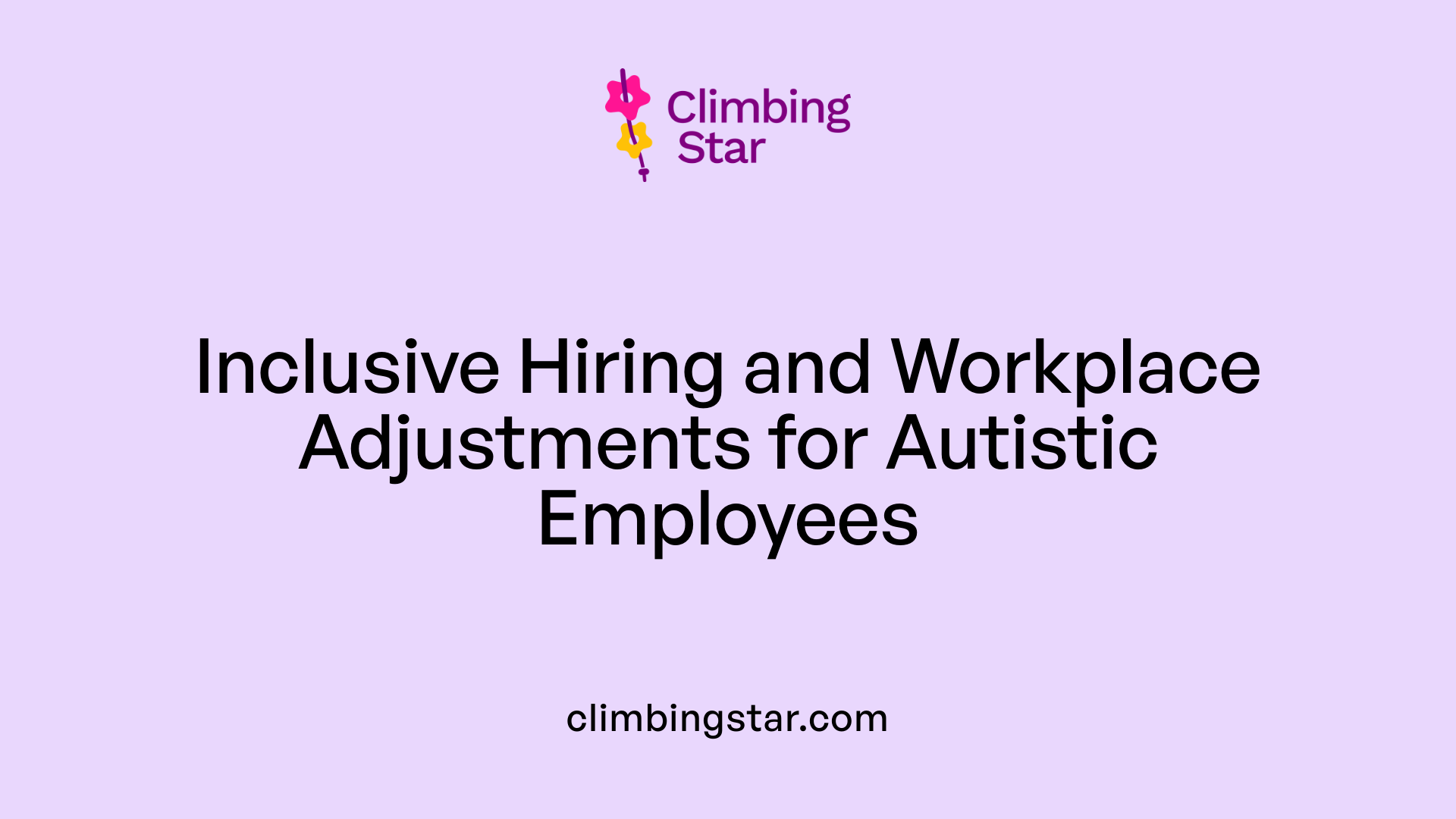
What strategies support the inclusion of autistic employees?
Inclusive hiring practices that recognize the value of neurodiversity play a crucial role in supporting autistic employees. Many organizations are becoming more open to neurodiversity, adapting recruitment processes to lessen social skill barriers typically encountered by autistic individuals. This includes offering alternative interview formats and providing clear, structured communication throughout the hiring process.
Accommodations in the workplace are essential to help autistic employees thrive. These may include flexible scheduling to reduce stress, remote work options to accommodate sensory sensitivities, providing quiet spaces to manage sensory overload, and using visual aids to make instructions clearer. Allowing the use of noise-canceling headphones and maintaining predictable routines are additional strategies that address common workplace challenges such as sensory sensitivities and anxiety.
Benefits of inclusive workplaces
Creating inclusive environments benefits both employees and organizations. Autistic individuals contribute unique strengths in attention to detail, pattern recognition, and focused task completion, which are valuable across multiple industries including IT, research, design, and education. By tailoring workplace supports, employers not only improve job retention and satisfaction among autistic employees but also enhance overall productivity and innovation within their teams.
Open disclosure of an autism diagnosis can encourage the use of accommodations and ongoing support while fostering a culture of understanding. Employers who prioritize inclusivity help reduce discrimination and chronic stress experienced by autistic workers, promoting healthier and more sustainable employment relationships.
In summary, neurodiversity-sensitive hiring paired with thoughtful accommodations creates workplaces where autistic adults can utilize their talents effectively, leading to improved employment outcomes and enriched organizational culture.
Challenges of Recruitment and Interview Processes for Autistic Adults
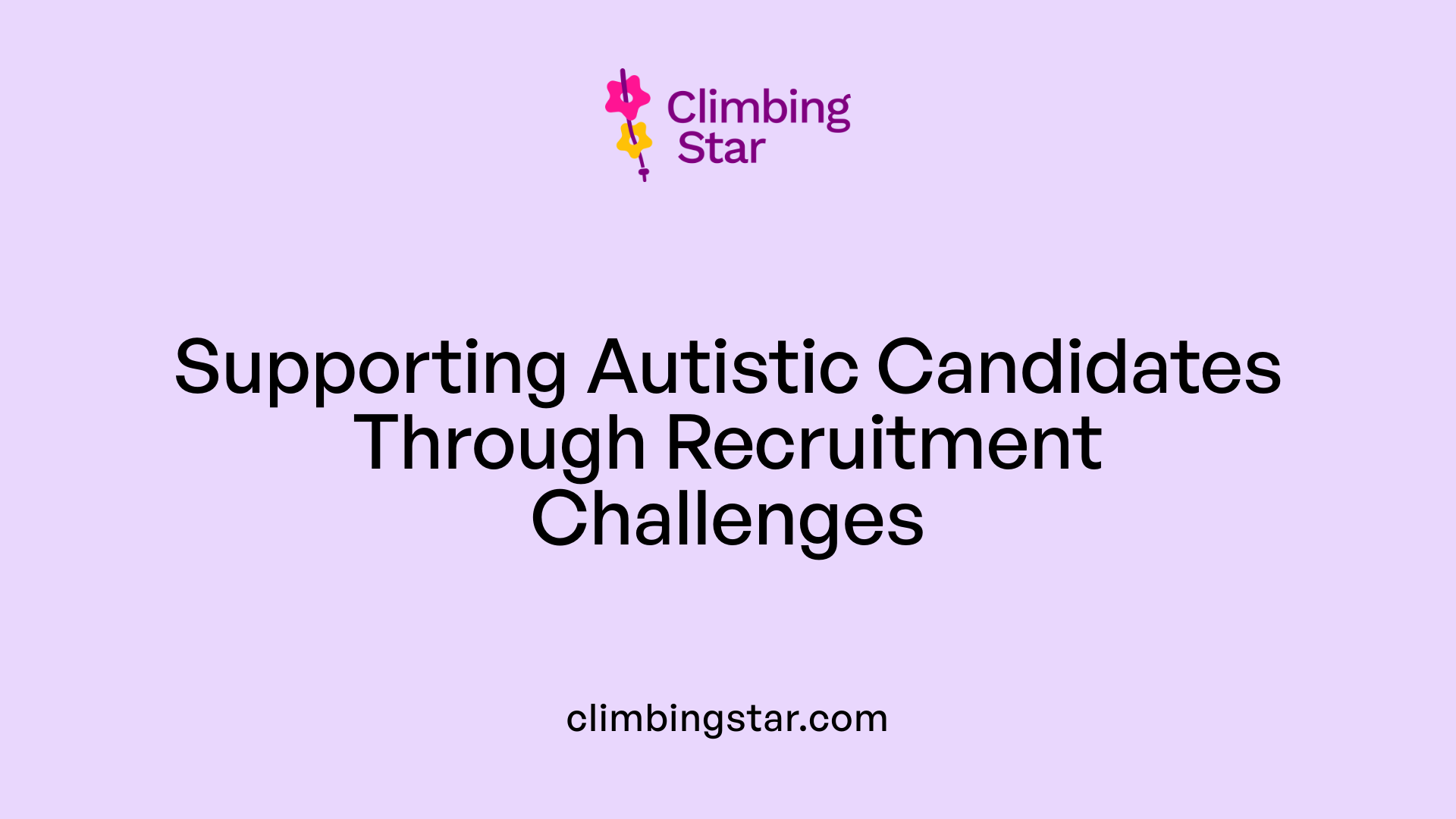
Why do autistic adults find recruitment and interviews challenging?
Many autistic adults face difficulties in recruitment and interviews because these processes often emphasize social skills that do not easily align with their natural communication styles. Social interaction demands during interviews, such as reading nonverbal cues, engaging in small talk, and quickly responding to unstructured questions, can cause stress and confusion. These challenges can hinder their ability to showcase their true skills and qualifications effectively.
Navigating recruitment: Difficulties and strategies
The traditional recruitment process is not always designed with neurodiversity in mind. For autistic candidates, unclear expectations, ambiguous questions, and the emphasis on interpersonal skills may create additional obstacles. Such factors contribute to the lower employment rates observed among autistic adults despite many having high educational attainments.
To support these candidates, some organizations have started to adopt alternative interview formats. These include providing written or clear instructions beforehand, utilizing structured interviews with consistent questions, and focusing more on practical skill assessments rather than social interactions alone.
Trends in accommodations and growing awareness
Increasingly, workplaces are recognizing the benefits of embracing neurodiversity and are adjusting hiring practices accordingly. Accommodations like allowing extra time for responses, offering quiet interview settings, or permitting the presence of a support person during interviews are becoming more common. This shift not only eases the recruitment process for autistic individuals but also helps employers tap into a pool of talented candidates with unique strengths.
These emerging trends reflect a positive movement toward inclusive hiring practices that acknowledge and adapt to the barriers faced by autistic adults, improving their chances of gaining meaningful employment.
High Educational Attainment Amidst Employment Struggles

What is the relationship between educational qualifications and employment for autistic adults?
Many adults with autism spectrum disorders (ASD), especially those diagnosed later in life without intellectual disabilities, showcase impressive educational achievements. Over 56% hold university entrance certificates, and nearly 25% have completed Master's degrees or diplomas. This indicates a strong academic foundation among autistic adults, challenging some stereotypes about ASD and intellectual capacity.
However, these high qualifications do not always translate into employment that matches their skills and education. Studies reveal that roughly 13.5% of autistic adults face unemployment, while around 17% retire early. More strikingly, a significant portion experiences overeducation — meaning they work in roles that do not fully utilize their qualifications. For instance, 22.1% were overeducated in their longest-held jobs, and this figure increases to 31.3% in their current roles. This overeducation rate surpasses those seen in the general population, emphasizing challenges in maintaining suitable employment.
This mismatch points to systemic barriers beyond academic preparedness. Difficulties navigating social expectations, adapting to work environments, and encountering workplaces that may not accommodate their needs contribute to employment struggles. Many autistic adults are employed across diverse sectors such as health, social services, education, science, and technology, but retaining positions that align with their skills requires better support.
Targeted employment support programs focused on job training, workplace accommodations, and inclusive hiring are vital. These interventions could help autistic adults secure and sustain employment appropriate to their qualifications, reducing the high rates of overeducation and unemployment. Addressing these gaps will maximize the potential and contributions of autistic individuals within the labor market.
Sector Employment Patterns of Autistic Adults
In which sectors are adults with ASD commonly employed?
Adults with autism spectrum disorders (ASD) are represented across a broad range of employment sectors, demonstrating the diverse capabilities within the autistic community. Notably, many autistic adults find roles in the health and social sectors, where their detail-oriented nature and dedication can benefit patient care and support services.
Teaching and education also employ a significant number of individuals with ASD. These roles often capitalize on their strengths in structured tasks and knowledge sharing, making educational environments a common workplace.
Scientific and technological fields are another important area of employment for autistic adults. The analytical skills and focused interests characteristic of many autistic individuals align well with careers in research, IT, design, and other technology-driven industries.
Together, these sectors show the varied opportunities available to autistic adults despite the challenges they may face in the labor market. Their participation highlights the importance of inclusive hiring practices that recognize the unique contributions that autistic employees can bring to different professional settings.
Impact of Disclosure of Autism Diagnosis at Work
What is the impact of disclosing an autism diagnosis at work?
Disclosing an autism diagnosis in the workplace can significantly improve access to necessary accommodations that help autistic employees thrive. When employers are aware of an individual's diagnosis, they are better positioned to provide tailored support such as quiet workspaces, flexible schedules, and the use of assistive tools like visual aids or noise-canceling headphones. These accommodations can reduce sensory overload and ease communication challenges, contributing to a more comfortable and productive environment.
Moreover, disclosure often leads to enhanced understanding among colleagues and supervisors, which can foster a more inclusive and supportive workplace culture. This environment not only helps in managing workplace stressors but also encourages better social interactions.
Importantly, studies show that having access to these supports through disclosure is associated with improved job retention for autistic adults. This is critical given the high unemployment and underemployment rates among this population despite their often high qualifications.
However, deciding whether to disclose is a personal choice. Concerns about stigma or discrimination may influence this decision. Therefore, workplaces that promote neurodiversity and ensure confidentiality are vital to encourage disclosure and maximize benefits for autistic employees.
Managing Workplace Setbacks: Discrimination and Stress
How do autistic employees handle setbacks like discrimination and chronic stress?
Autistic employees often face significant setbacks in the workplace, including discrimination, difficulty fitting in, and chronic stress. Handling these issues effectively involves several strategies.
Open communication with employers plays a vital role. When autistic workers disclose their diagnosis and explain their needs, it can lead to reasonable workplace adjustments, such as quiet zones, flexible schedules, and the use of visual aids. These accommodations help reduce stress and create a more inclusive environment.
Supportive workplace cultures and clear anti-discrimination policies are essential. They encourage understanding and prevent exclusion, which significantly improves job sustainability for autistic employees.
In cases where discrimination occurs, autistic workers can seek legal protections under disability rights laws. These protections enforce reasonable accommodations and guard against unfair treatment.
Overall, coping with workplace setbacks requires a combination of personal advocacy, employer cooperation, and legal safeguards. Together, these elements foster a work environment where autistic individuals can thrive despite the challenges of discrimination and stress.
Tailored Support Programs to Enhance Employment Stability
What role do support programs play in improving employment for adults with ASD?
Support programs play a crucial role in bridging the gap between the qualifications and abilities of adults with autism spectrum disorder (ASD) and their successful integration into the workforce. Programs that offer job coaching and vocational training prepare autistic adults by teaching essential job-related skills such as following instructions, managing time, and completing tasks efficiently.
Alongside skill development, workplace accommodations form a vital element of these support strategies. Adjustments like visual aids, quiet workspaces, and flexible schedules help mitigate challenges tied to sensory sensitivities and communication differences. These changes, combined with social skills training, foster environments where autistic employees can thrive.
By providing targeted assistance tailored to individual needs, these programs not only enhance employment stability but also ensure job roles align better with each person's unique strengths. This alignment has the potential to reduce overeducation concerns and improve job satisfaction among adults with ASD.
These support initiatives are especially important in industries where autistic individuals commonly work, such as technology, research, and education, helping them to overcome barriers linked to atypical communication styles and the need for routine. In sum, supportive interventions contribute significantly to sustainable employment outcomes for adults on the autism spectrum.
Industries Aligning Well with Autistic Strengths
Which industries tend to be well-suited for autistic workers?
Certain industries such as information technology (IT), scientific research, design, manufacturing, animal care, and library work often align well with the strengths and preferences of autistic employees. These sectors typically offer roles that can capitalize on skills like strong attention to detail, pattern recognition, dedication to routine tasks, and a preference for structured environments.
In IT and research, autistic individuals may excel by leveraging their analytical abilities and focus to manage complex tasks or data. Design fields can benefit from unique creativity and precision, while manufacturing positions often involve repetitive, well-defined processes that provide predictability.
Animal care and library work are particularly suited to those who thrive in quieter, less socially demanding settings. These roles often allow for tangible, hands-on activities and may reduce the sensory overload common in fast-paced, unpredictable work environments.
Employers in these industries who incorporate inclusive hiring practices and appropriate accommodations—such as flexible schedules, quiet workspaces, and clear communication—can foster retention and improved performance among autistic employees. Aligning job roles with an individual’s strengths not only benefits the employee but also contributes positively to workplace diversity and productivity.
Overall, these sectors represent promising areas for targeted employment support programs aimed at improving job stability and satisfaction for autistic adults.
Workplace Strategies to Mitigate Sensory Overload and Anxiety
How can workplace strategies reduce anxiety and sensory overload for autistic employees?
Employers can create a supportive work environment for autistic employees by focusing on approaches that minimize sensory overload and reduce anxiety. One effective method is establishing predictable routines and consistent schedules, which helps autistic individuals anticipate their daily tasks and avoid unexpected changes that could cause stress.
Improving communication is also essential. Using visual aids and clear, direct instructions can support understanding and reduce misunderstandings. These tools accommodate various communication styles and make interactions smoother.
Workplaces can further ease sensory sensitivities by providing quiet spaces and the option to use headphones, allowing employees to control their environment better. Stress management supports and job coaching also help employees build coping strategies.
Overall, these strategies collectively enhance the work experience and productivity for autistic employees by addressing their unique sensory and anxiety-related challenges and fostering a more inclusive atmosphere.
The Need for Targeted Employment Support Programs for ASD Adults
What labor market challenges do adults with ASD face?
Adults with autism spectrum disorder (ASD) encounter significant hurdles in the labor market despite often possessing high educational qualifications. Employment rates for autistic adults hover around 21–27%, markedly lower than those of the general population. Even among those with university entrance certificates or advanced degrees, many experience unemployment, early retirement, or overeducation — working in roles that do not match their qualifications.
These challenges stem from several factors: difficulty adapting to social and communication demands during recruitment and on the job, sensory sensitivities that make typical workplaces overwhelming, and a mismatch between an individual's strengths and the nature of available jobs. Social misunderstandings and anxiety, along with the need for predictable routines, often impede stable employment.
Why are targeted employment support programs necessary for adults with ASD?
Targeted employment support programs are vital to bridge the gap between autistic individuals’ capabilities and workplace demands. They provide specialized assistance to address social skill challenges, sensory processing issues, and job skill development. Programs may include job coaching, vocational training, and workplace accommodations tailored to each individual's needs.
These interventions help autistic adults develop skills such as task management, communication, and self-regulation, enabling them to navigate workplace dynamics more confidently. Equally important, employers who implement inclusive hiring practices and create supportive environments contribute to increased employment retention and job satisfaction for autistic employees.
By addressing the unique barriers faced by adults with ASD in the labor market, these support programs facilitate improved employment outcomes, reduce overeducation and underemployment, and promote fuller participation in diverse occupational fields. Ultimately, such targeted initiatives help unlock the potential of autistic workers while fostering more diverse and inclusive workplaces.
Toward More Inclusive Workplaces for Autistic Adults
The autism unemployment rate highlights persistent systemic challenges faced by this community despite educational achievement and diverse talents. Evidence-based therapies like ABA play a vital role in preparing autistic individuals for workforce participation by building essential skills and self-regulation. Equally important are workplace adaptations, inclusive hiring practices, and targeted support programs that recognize and accommodate unique needs. By fostering neurodiversity-aware environments and offering tailored accommodations, employers can unlock the full potential of autistic employees, benefiting both individuals and organizations. The path forward lies in collaborative efforts to bridge gaps between autistic workers and labor markets, promoting dignity, opportunity, and sustainable employment for all.
References
- Understanding Autism Employment
- Autism at Work: Overcoming Challenges
- Education and employment status of adults with autism ...
- ABA Techniques: Strategies for Behavior Analysts - GSEP Blog
- Applied Behavior Analysis (ABA)
- Applied Behavior Analysis (ABA)
- The Top 10 Reasons Children With Autism Deserve ABA
- 6 Benefits of ABA Therapy for Children with Autism







